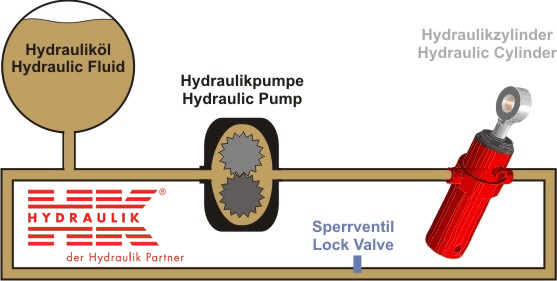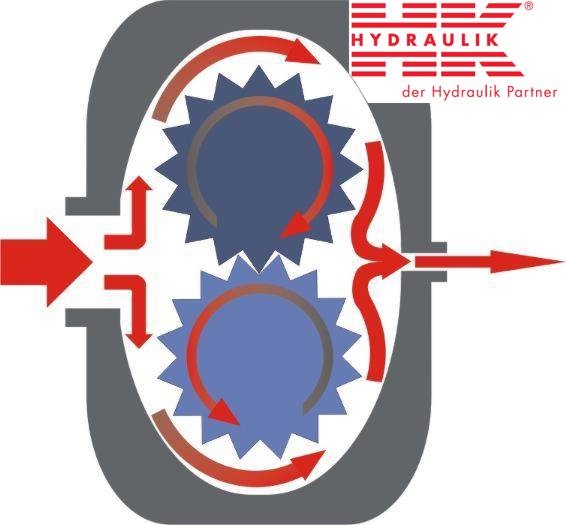A brief hydraulics encyclopaedia
Hydraulics is a neologism from the Ancient Greek terms “hydro” (water) and "aulos" (pipe). In general, hydraulics deals with the flow behaviour of liquids. In the particular case of the construction machinery sector, it deals with power and energy transfer using liquids.
Hydraulics in history
In 1600, Johannes Kepler invented the gear pumpThe oil volume enclosed in the gap between teeth is conveyed from the intake to the discharge side of the pump by the turning of the gear, displaced to the contact point of the wheel and forced into the pressure connection.. However, at first this invention had no consequences. Blaise Pascal laid the foundations for the further development of hydraulics with the “hydrostatic law”. In 1663, he elucidated the principle of the hydraulicThe use of liquids to transmit force and energy. press. Joseph Bramah is considered the founder of hydraulics technology.

From a historical point of view, the Englishman Joseph Bramah (1749 - 1814) (right image) is seen as the founder of hydraulics technology.
In 1795, he developed a machine powered by pressurised water, which increased the force applied 2000 fold.
The year 1905, when Williams and Janney first used mineral oil as the transfer medium for a hydrostatic transmission driven by axial pistons, marks the beginning of oil hydraulics.
The first power steering system was developed by VickersVickers Limited was an important British mechanical engineering and defence group founded in 1828. In 2004, BAE Systems acquired the Alvis group and incorporated Alvis Vickers into its military division, BAE Land Systems. (in 1925), who also developed the first pre-controlled pressure valve in 1936.
These inventions provided the basis for modern hydraulics technology.
Types of hydraulic power transmission
Three different types of hydraulic power transmission can be differentiated:
- the hydrodynamic drive
- viscous coupling
- the hydrostatic drive
Hydraulic systems in construction machinery
In construction machinery, the hydrostatic drive is mainly used to provide hydraulic power transmission. Hydrostatic drives convert the mechanical power of a drive motor into hydraulic power via a pump. In this respect, they are the ideal solution for construction machines since they enable continuous adjustment of the output speed
The pump and motor proportions are very similar in hydrostatic drives. The structure is usually a finger piston pump (axial piston pumpAxial piston pumps come in swash plate, bent axis, and wobble plate constructions and are designed for the medium and high pressure ranges.). The pump housing is position axial to the drive shaft. Inside is a ring with cylinder bores arranged in circles, in which finger pistons are deployed in the same arrangement. Axial piston motors are used both in industrial applications (e.g. heavy machinery construction) and in mobile working machines. The design is usually that of hydraulic motorsHydraulic motors or hydromotors convert the energy generated by hydraulic pumps back into mechanical work. Many pumps can be used as hydromotors as well without changes to the construction.. They can have a constant or variable displacement.
Hydraulic cylinderConverts the energy from the hydraulic fluid into a simple linear force.s are used to generate a linear movement.
Turning movements on the other hand are produced with hydraulic motorHydraulic motors or hydromotors convert the energy generated by hydraulic pumps back into mechanical work. Many pumps can be used as hydromotors as well without changes to the construction.s, or hydro motorHydraulic motors or hydromotors convert the energy generated by hydraulic pumps back into mechanical work. Many pumps can be used as hydromotors as well without changes to the construction.s.
This hydraulics system always requires a circulation of the fluid (mineral oil, hydraulic oilThe pressurised fluids used in hydraulic systems must fulfil different functions: pressure transmission, corrosion protection, lubrication, dust removal etc., esters, glycols, or special water mixtures. Since the compression of these hydraulics liquids is low, high forces can be transmitted very uniformly and precisely.
The principle of how a hydraulic pump works

The fundamental advantage of these hydraulics systems lies in the separate construction method: the hydraulics can be perfectly adapted to the machine using freely moveable pipes and tubes. This is also made possible thanks to the great power of the comparatively small components.
Furthermore, these systems offer other advantages, such as:
- continuously variable speed setting of drive within wide limits,
- easy to reverse direction of movement
- easy to generate very great forces and torques
- safe and fast-acting overload protection by means of pressure relief valve
- implementation of parallel or rotatory output elements (hydraulic cylinders or hydromotors) with a primary component (pump) in a combined system, producing the effect of a differential without additional effort.
- long service life, since the fluid is self-lubricating and acts as a cooling medium
- simple regulatory concept to make the best use of the drive motor with widely varying performance requirements of the working machine.
- very precise adjusting
- simple display of load by pressure measurement device
- start-up from standstill to full load
- corrosion protection by hydraulic liquids (except water)
Practical experience shows the disadvantages of the hydraulics system to be:
- High requirement for filtering of the hydraulic liquid
- Loss of oil through leakage
- High flow losses within the hydraulic liquids, which are converted into heat and heat up the equipment. (Loss of energy – occurs especially with older pumps and motors)
Due to their specific advantages and disadvantages, hydraulic drives are often used in mobile working machines such as construction or agricultural machinery. In these machines, loads are mainly lifted and lowered by hydraulic cylinders that move linearly.
Further examples of typical applications are:
- Two-way excavators
- In agriculture, with tractors, to lift, propel, or control accessory equipment
- Excavators: hydraulic drive of all working equipment including slewing gear and chassis
- Mobile cranes: hydraulic drive of telescope masts, winches and hoists, slewing gear, bracing, steering, and in some cases travel drive
- Forestry machinery: hydrostatic travel and working drives
More on the subject of hydraulics:
Displacement
In the fluid technology of hydraulic motors, displacement is the quantity of hydraulic liquid that the hydraulic motor uses per rotation. In adjustable hydraulic motors, the displacement is variable. The output power P of a hydraulic motor is directly proportionate to the displacement V, the rotation speed n, and the pressure gradient Δp. The product of the volume flow rateVolume flow rate is the volume of hydraulic liquid that moves through a cross section within a period of time. supplied Q and the displacement gives the rotation speed. The pressure gradient is difference between the pressure of the inflowing hydraulic liquid (usually pump pressure) and the pressure of the outflowing hydraulic liquid (usually tank pressure).
Gear pump
The gear pump is a device for the transport of liquids and the power transmitting propulsion of hydraulic motors. It is a sub-type of displacement pumps. A gear pump transports the medium to be pumped uniformly (regardless of the hydrostatically caused pulsation), and can bear average pressures of up to ca. 300 bar. As in all hydraulic systems, the pressure is adjusted against a load by transporting the medium. If the load increases, the pressure rises. The means of propulsion for hydraulic power converters in construction machinery, tractors, and in craft and industry, especially vehicle construction.
(Reference: Wikipedia / various technical encyclopaedias / own work)







